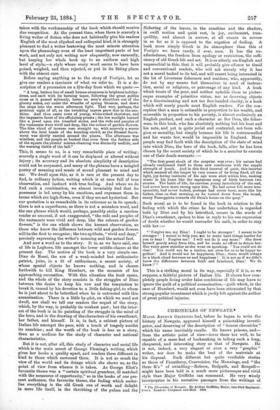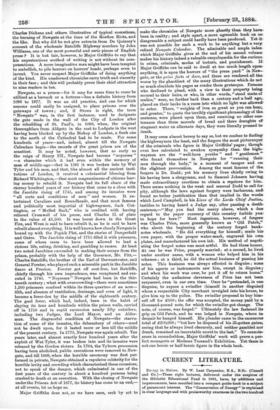CHRONICLES OF NEWGATE.* MAJOR ARTHUR GRIFFITHS had, before he began
to write the history of Newgate, approved himself a painstaking investi- gator, and deserving of the description of "honest chronicler" which his name inevitably recalls. He knows prisons, and— from the artistic point of view—loves them too well, to be capable of a mere feat of bookmaking in telling such a long, chequered, and interesting story as -that of Newgate. He is not, indeed, a very elegant or even a very " graphic " writer, nor does he make the best of the materials at
his disposal. Such different but quite verifiable stories as those of Fauntleroy, Courvoisier, the Mannings, and "the three H's" of swindling—Robson, Redpath, and Roupell- might have been told in a much more picturesque and vivid style than Major Griffiths can command. He very wisely incorporates in his narrative passages from the writings of * The Chrcmialu of Newgate. By Arthur Griffiths, Major, late 83rd Regiment. 2 To a. London: Caapman and BItil. 11184.
Charles Dickens and others illustrative of typical executions, the burning of Newgate at the time of the Gordon Riots, and the like. But why did he not give extracts from De Quincey's account of the wholesale Ratcliffe Highway murders by John 'Williams, one of the most powerful and eerie pieces of English prose ? It is but fair, however, to Major Griffiths to say that his unpretentious method of writing is not without its com- pensations. A more imaginative man might have been tempted to embellish, to pile horrors on horrors' heads, perhaps even to invent. You never suspect Major Griffiths of doing anything of the kind. His unadorned chronicles carry truth and sincerity in their face ; and this will probably prove their chief attraction to nine readers in ten.
Newgate, as a prison—for it may for some time to come be utilised as a barrack or a fortress—has a definite history from 1086 to 1877. It was an old practice, and one for which reasons could easily be assigned, to place prisons over the gateways of towns ; and, if Stowe is right, the term " Newgate " was, in the first instance, used to designate the gate made in the wall of the City of London after the rebuilding of St. Paul's, in 1086, when, the original thoroughfare from Aldgate in the east to Ludgate in the west having been blocked up by the Bishop of London, a fresh one to the north of the Cathedral had to be made. For some hundreds of years—and, indeed, almost till the Newgate Calendars begin—the records of the great prison are of the scantiest. It may be noted, however, that as early as the reign of Henry III., Newgate had become " noysome " —a character which it had even within the memory of men of middle-age—that in 1381 it was broken into by Wat Tyler and his men, and that, like almost all the ancient insti- tutions of London, it received a substantial blessing from Richard Whittington,—that most magnanimous of citizens leav- ing money to rebuild it. Newgate had its full share of the stormy hundred years of our history that came to a close with the Jacobite rising of 1745, and among its inmates were "all sorts and conditions of men" and women. It en- tertained Cavaliers and Roundheads, and that most famous and politically most impartial of highwaymen, Jack Cot- tington, or "Mulled Sack," who is credited with having relieved Cromwell of his purse, and Charles II. of plate to the value of £1,500. It was burnt down in the Great Fire, and Wren is said to have rebuilt it, as he is said to have rebuilt almost everything. It is well known how closely Newgate is bound up with the Popish Plot, and the stories of Dangerfield and Oates. The Jacobite rising of 1715 filled it with prisoners, some of whom seem to have been allowed to lead a riotous life, eating, drinking, and gambling to excess. At least two noted Jacobites succeeded in making their escape from the prison, probably with the help of the Governor, Mr. Pitt,— Charles Ratcliffe, the brother of the Earl of Derwentwater, and General Forster, who played such a miserable part in the Jacobite fiasco at Preston. Forster got off scot-free, but Ratcliffe, chiefly through his own imprudence, was recaptured and exe- cuted in 1745. " Noysome " Newgate had been in the thir- teenth century ; what with overcrowding—there were sometimes 1,200 prisoners confined within its three-quarters of an acre— filth, and absence of ventilation, drainage, and even of light, it became a fever-den by the middle of the eighteenth century. The gaol fever, which had, indeed, been in the habit of slaying its tens and hundreds within the prison walls, carried off in 1750 and in rapid succession nearly fifty outsiders, including two Judges, the Lord Mayor, and an Alder- man. The disgraceful condition of Newgate—the starva- tion of some of the inmates, the debauchery of others—need not be dwelt upon, for it lasted more or less till the middle of the present century. In 1770, Newgate was again rebuilt. Ten years later, and almost exactly four hundred years after the exploit of Wat Tyler, it was broken into and its inmates were released by the Gordon rioters. In 1784, the Tyburn procession having been abolished, public executions were removed to New- gate, and till 1868, when the horrible ceremony was first per- formed in private, Newgate obtained a repulsive celebrity for the horrible levity and crowding which characterised these occasions, not to speak of the danger, which culminated in one of the first years of the century in about a hundred persons being crushed to death at an execution. With the closing of Newgate under the Prisons Act of 1877, its history has come to art end,— at all events, let us hope so.
Major Griffiths does not, as we have seen, seek by art to make the chronicles of Newgate more ghastly than they have been in reality ; and style apart, a more agreeable book on so. disagreeable a subject could hardly have been produced. Yet it was not possible for such a work to be anything bat a very refined Newgate Calendar. The admirable and ample index which Major Griffiths gives at the end of his second volume makes his history indeed a valuable encycloptedia for the curious in crime, criminals, modes of torture, and punishment. If. Major Griffiths can be said to dwell at too much length upon; anything, it is upon the horrors of "the press yard" in New-- gate, or the peine forte et dure, and these are rendered all the, worse by the ghastliest of the many illustrations which do not so much elucidate his pages as render them grotesque. Persons who declined to plead, with a view to their property being secured to their heirs, or who, in other words, "stood mnte.of malice," were, no further back than a century and a half ago, placed on their backs in a room into which no light was allowed) to enter. There, "weights of iron as great as you can bear, and greater," to quote the terribly significant phraseology of the. sentence, were placed upon them, and receiving no other awes tenance than three morsels of bread and three draughts of stagnant water on alternate days, they were literally pressed to death.
It may seem almost heresy to say so, bat we confess to finding the highwaymen the least, and the forgers the most picturesque of the criminals who figure in Major Griffiths' pages ; though even less calculated to awaken sympathy than the highs, waymen are the "well-born youths" and "gentlemen ' who found themselves in Newgate for "running their, men through the body," in a moment of temper and on; the slightest provocation. Among the most famous of the, forgers is Dr. Dodd; yet his memory lives chiefly owing to his having been a clergyman, and to Samuel Johnson having made extraordinary exertions to obtain a reprieve for him. There seems nothing in the weak and sensual Dodd to call for pity, although the laws against forgery were barbarous, and found no better justification than that implied in the words which Lord Campbell, in his Lives of the Lords Chief Justioe, testifies to having heard a Judge say, after passing a deaths sentence,—" May you find the mercy above, which a dins regard to the paper currency of this country forbids you: to hope for here !" Most ingenious, however, of forgers. was Charles Price, more generally known as "Old Patch,' who about the beginning of the century forged bank- notes wholesale. "He did everything for himself ; made his- own paper, with the proper water-mark, engraved his MS plates, and manufactured his own ink. His method of negoti- ating the forged notes was most artful. He had three homes. At one he was Price, properly married; at a second, he lived. under another name, with a woman who helped him in his schemes ; at a third, he did the actual business of passing his notes. This business was always effected in disguise ; none of his agents or instruments saw him, except in disguise;. and when his work was over, he put it off to return home." Certainly the audacious cleverness of Price has not been= surpassed, even in our own time. Once he "pretended, in one disguise, to expose a swindler (himself in another disguiser whom a respectable City merchant inveigled into his house, to give him up to the police. The swindler proposed to buy him- self off for £500; the offer was accepted, the money paid by as thousand-pound note, for which the swindler got change. The note, of course, was forged." Ultimately the law fastened its grip on Old Patch, and he was lodged in Newgate, where rn. despair he hanged himself. His plunder came to the enormous total of 2200,000; "but how he disposed of his ill-gotten gains, seeing that he always lived obscurely, and neither gambled nor drank, remained an inscrutable secret to the last." To connois- seurs in scoundreldom, Major Griffiths' work will prove a per- fect menagerie or Madame Tussaud's Exhibition. Yet them is not one heroic or half-heroic figure in the whole book.



































 Previous page
Previous page